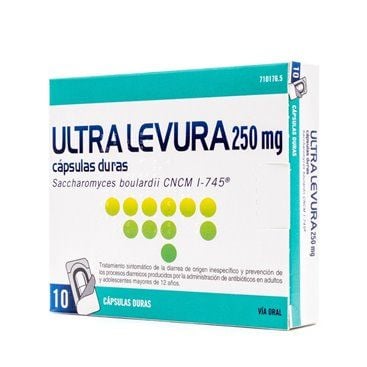Ultra-Levura 250 Mg 10 Capsules (Blister)
Ultra-Levura is a medicine that contains the active substance a probiotic yeast called Saccharomyces boulardii. It is indicated for the symptomatic treatment of diarrhea of non-specific origin and prevention of diarrheal processes caused by the administration of antibiotics in adults and adolescents over 12 years of age.
Ultra-Levura is a medicine that contains the active substance a probiotic yeast called Saccharomyces boulardii. It is indicated for the symptomatic treatment of diarrhea of non-specific origin and prevention of diarrheal processes caused by the administration of antibiotics in adults and adolescents over 12 years of age.
Ultra-Levura (250 Mg 10 Capsules (Blister))
ACTION AND MECHANISM
Antidiarrheal. Bacterial microorganism. It works by replacing the pathogenic flora of the intestine with another similar to the physiological one.
INDICATIONS
- Symptomatic treatment of non-specific acute [DIARRHEA] and in the prevention and symptomatic treatment of diarrheal processes produced by the administration of antibiotics.
POSOLOGY
"CAPSULES"
- Adults and adolescents > 18 years: 250-500 mg/24 h, divided into 2 doses in the morning and at night.
- Children < 12 years: this presentation is not adapted for these children.
- Elderly: no specific dosage recommendations have been established.
RULES FOR CORRECT ADMINISTRATION
- Capsules: swallow whole with a glass of water.
Due to the risk of atmospheric contamination, sachets or capsules should not be opened in patient rooms. Healthcare professionals should wear gloves when handling probiotics for administration and promptly dispose of them afterwards and wash their hands properly.
Administration with food: administer preferably before meals.
CONTRAINDICATIONS
- Hypersensitivity to the active ingredient, to yeasts (especially Saccharomyces boulardii) or to any of the excipients.
- Patients with central venous catheter.
- Seriously ill patients or patients with [IMMUNODEFICIENCY] due to a risk of fungemia (see PRECAUTIONS).
PRECAUTIONS
- Infection. Very rare cases of fungemia with fever (and positive blood cultures for Saccharomyces strains) have occurred, mainly in severely ill or immunocompromised patients with central venous catheters. In most cases, the patient recovered by discontinuing treatment, administering antifungals, and removing the catheter when necessary. However, fatal cases have been described (see Contraindications).
Pay special attention to the handling of the drug in the presence of patients mainly with a central venous catheter, but also with a peripheral catheter, even if they do not receive treatment with Saccharomyces boulardii, to avoid any contamination through the hands or the spread of microorganisms through the air.
PRECAUTIONS RELATED TO EXCIPIENTS
- This medicine contains lactose. Patients with hereditary [LACTOSE INTOLERANCE] or galactose, the Lapp lactase deficiency, or glucose-galactose malabsorption should not take this medicine.
ADVICE TO THE PATIENT
- Notify your doctor and/or pharmacist if diarrhea persists for more than 2 days or if blood appears in the stool or fever.
SPECIAL WARNINGS
- Evaluate the patient if the diarrhea persists for more than 2 days or blood appears in the stool or fever, reconsidering the treatment and the need to introduce oral or parenteral rehydration.
- Cases of fungemia have been reported in patients treated with Saccharomyces boulardii, including some with fatal outcome in critically ill patients. For this reason, its use is contraindicated in critically ill patients, as well as in immunocompromised patients, and in carriers of a central venous catheter. On the other hand, patients who are in close proximity to those who are being treated with S. boulardii may also be exposed to the risk of contamination by the microorganisms in the drug. Therefore, special attention should be paid when handling the product in the presence of critically ill or immunosuppressed patients, or in front of carriers of a central or peripheral venous catheter who are not being treated with this medicine. To avoid any contamination through the hands or the spread of microorganisms by air, sachets or capsules should not be opened in patient rooms. Healthcare professionals should wear gloves when handling probiotics and then promptly dispose of them and wash their hands properly.
INTERACTIONS
- Oral or systemic antifungal treatments, due to the fungal nature of the yeast saccharomyces boulardii. Avoid co-administration.
- Very hot drinks or food (above 50ºC), ice cream or that contain alcohol since Saccharomyces boulardii contains living cells. Avoid administering sacharomyces boulardii with this type of food or drink.
PREGNANCY
Safety in animals : no data available.
Safety in humans : Adequate and well-controlled studies in humans are not available. Its administration is only accepted if there are no safer therapeutic alternatives, and the benefits outweigh the possible risks.
Effects on fertility : No specific studies in humans have been performed.
LACTATION
There are no relative data in lactating women. Although Saccharomyces boulardii is not absorbed, it is preferable to assess the benefit/risk ratio before using it during lactation.
ADVERSE REACTIONS
Adverse reactions are described according to each frequency interval, being considered very common (>10%), common (1-10%), uncommon (0.1-1%), rare (0.01-0.1%). , very rare (<0.01%) or frequency unknown (cannot be estimated from the available data).
- Digestive: rare [FLATULENCE].
- Infectious: very rare fungemia in patients with central venous catheter and in critically ill or immunocompromised patients (see Precautions and Contraindications).
- Allergic: very rare [HYPERSENSITIVITY REACTIONS], with [PRURITUS], [URTICARIA], [EXANTEMATIC ERUPTIONS], [ANGIOEDEMA] or [ANAPHYLAXIS].



